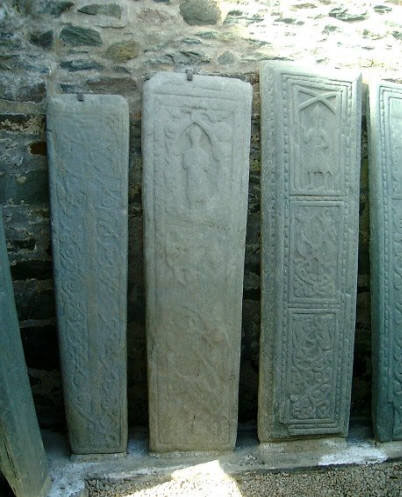Kilmartin graveslabs.

Kilmartin graveslab
Before any discussion takes place it is necessary to clearly define what is meant by graveslabs and gravestones. Graveslabs are large flat pieces of stone (nearly always carved but not always decorated) which lay on the ground covering a burial site. Gravestones are upright ‘markers’ which indicate a burial site.
At first sight these seem to be identical in function but this is not so and hence the need for a clear definition. Graveslabs primarily serve to cover and protect a body whereas a gravestone does not. Its function is show the place of burial and frequently the details of the deceased. Both graveslabs and gravestones may, or may not, provide identification details. Generally, graveslabs date from before the Reformation (1559) and gravestones after, although there is a considerable transition period.
To the right are some graveslabs to be found at Kilmartin. They have been moved indoods for prtection and now stand upright which may have introduced some confusion regarding graveslabs or gravestones discussed above.

Kilmartin graveslab
The badly weathered stone to the left is 1.76 meters in height (5′ 6″) and bears as decoration a single sword surrounded by plant stems terminating in two dragon’s heads at the bottom. The top of the graveslab is decorated with an interlaced cross of arcs. It has been suggested that this cross is a Knight Templar cross, or cross patee but we shall reserve judgment until more material has been accumulated and discussed.
The symbolism on this and other similar stones will be discussed elsewhere in these pages.
In addition we have provided black and white photographs of this slab (at the far left in the above image) as it shows the decoration in more detail.